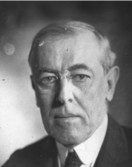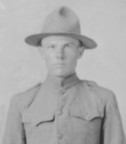|
|
|
|
January 2022

|
|
"...nor snow. nor dark of night..."
Daily Taps at the National WWI Memorial sounded despite inclement DC weather
Connecticut's 1st Official State Troubadour Connects to World War I

The American railroad system faltered under the heavy demands of a wartime economy in 1917, resulting in materials being unable to be loaded and shipped on trains. On December 26, 1917, President Wilson issued a declaration that he had nationalized the railroad system, and he ordered Secretary of War Newton Baker to take possession of the railroads on December 28, 1917. The National Constitution Center looks back at "one of the broadest acts of presidential power" which occurred during World War I. Click here to learn how Congressional action was repeatedly needed to return the railroads to private ownership at war's end.
|
Remembering My Grandfather,
Giovanni Carusone

A man is only missing if he is forgotten.
Our Doughboy MIA this month is Private Robert August Alsleben Company A/308th Infantry Regiment/77th Division.
Robert Alsleben was the 5th of 11 children born to Heinrich (Henry) and Cecelia Alsleben, a family of German immigrant farmers settled in Minnesota. Robert was born 01MAY1894 in Penn Township, McLeod County, Minnesota and worked the family farm up until his induction into the army on 28MAY1918 at New Auburn, Minnesota. He was received into the service at Camp Lewis, Washington in 43rd Company/11th Battalion/166th Depot Brigade until he was transferred to Camp Kearney, near San Diego, California in July and assigned to Company F/160th Infantry/40th ‘Sunshine’ Division. What little training Alsleben received was given here, and that wasn’t much as his unit spent almost half of their time at Camp Kearney (which was only a month) under quarantine for a possible Scarlet Fever outbreak. At the beginning of August, the 40th packed up and boarded trains for the Port of Embarkation at New York, sailing overseas 08AUG1918.
In France, the 40th Division was reassigned as the 6th Depot Division – meaning it became a replacement pool – and filtered its men into combat units depleted by casualties. Private Alsleben was transferred to Company A/308th Infantry/77th Division, being taken onto unit strength upon arrival on 23SEPT1918. Three days later, Company A (along with Company D) spearheaded the 308th’s drive into the Argonne Forest at the opening of the massive Meuse-Argonne Campaign. At this point, Alsleben had been in the army just two days shy of 4 months and had spent better than half of that time either in quarantine or travel.
A statement later given by a comrade says Alsleben was shot through the abdomen and right upper thigh while going over the top on the afternoon of 27SEPT1918, the second day of the Argonne fight, and killed instantly. No one, however, knew anything about his burial and as neither he nor his remains were ever found, he was declared as missing in action on 22OCT1918.
The story then gained new light when an International Red Cross report was received 16 APR1919 that contained a list of names from the Germans and dated 01MAR1919 showing that Alsleben had been captured that same day he was wounded and died of his wounds on 28SEPT1918 at Landwehr Infantry Field Hospital #13 in Grand Pre and had been buried in the German military cemetery there. No grave number was reported however, and when GRS officials went to look for him, they were unable to locate any remains, nor was a grave number found in surviving hospital records. In 1922, attempts were made by the German government to contact the head doctor who had worked at the hospital, but records do not say if this was successful or not. For a time, it appears there was some speculation Alsleben may have been recovered by the French and moved to the German military cemetery at Buzancy, but records do not say whether this lead was followed up on. Nothing more is known at this time.
Active investigation was suspended in the case in February 1929 and PVT Alsleben is memorialized on the Tablets of the Missing at the Meuse-Argonne American Cemetery at Romagne-sous-Montfaucon, France.
Can you spare just ten dollars? Give 'Ten For Them' to Doughboy MIA and help us make a full accounting of the 4,423 American service personnel still listed as missing in action from WW1. Make your tax deductible donation now, with our thanks.
Remember: A man is only missing if he is forgotten.
|
Merchandise from the Official
Doughboy Foundation WWI Store

Function and style are combined in this lightweight and compact Canvas & Leather Tote. You can show your American pride while carrying this Made in the USA dark khaki tote. Plenty of room for keys, wallet, tablet and documents. A distressed “U.S.” imprint is prominently displayed on the bag and an exclusive fabric garment label commemorates the U.S. Centennial of World War One.
This versatile canvas tote features:
- Constructed of heavy duty, touch dyed canvas and lined with 400 denier nylon
- Handles made of 6 Oz. top grain oil tanned leather, backed with 1” webbing
- Handle is attached to bag with distinctive “X” tacks.
- Dimensions: 18.5” W (seam to seam) x 13.5”H x 5.0”
- T-bottom style gusset
- Vintage Military style makes it great for him or her
- Made in USA
Proceeds from the sale of these books will help complete the new National World War I Memorial in Washington, DC.
This and many other items are available as Official Merchandise of the Doughboy Foundation.
|
|
|
|
|

Submitted by: Brian A. Huseland {great-nephew}
Theodore E Fournier was born around 1899. Theodore Fournier served in World War 1 with the United States Army. The enlistment was in 1917 and the service was completed in 1918.
Story of Service
My great-uncle Theodore Everett Fournier served in the 103rd Infantry, Company C. After his parents told Teddy in his teen years that he was adopted, he left home and enlisted in the Minnesota National Guard, 2nd Infantry, finding comfort in serving his country.
In 1916, they patrolled the U.S.-Mexico border because of Pancho Villa’s raids. In 1917, the boys were drafted into the American Expeditionary Forces, and trained at Camp Cody, NM, as part of the 34th “Sandstorm” Division. However, as some American regiments had encountered heavy losses in Europe, the 34th became a replacement division, and was broken up.
Teddy was shipped out from New York City on June 29th, 1918 on the ship Demosthenes. He carried with him standard issue uniform and equipment, and a precious item: an enlisted men’s prayer book. He arrived in mid-July and was assigned to the 103rd about the time of the Meuse-Argonne offensive. After resting and training the new recruits, the regiment boarded trains for Verdun, France. Teddy’s regiment prepared for the St. Mihiel Offensive as part of the 26th Division, encountering occasional gas and gunfire.
|

|
|
|
|